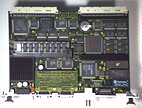
VMEbus Components
The „ P4X 060 system “ is a 6U VMEbus board build around the Motorola MC68060 microprocessor.It is ideal for high-end embedded real-time monitor, control and server applications. The combination of the high performance MC68060 and the IO versatility of the QUICC puts low cost features into a high performance single board VMEbus computer.The usage of the MC68EN360 QUICC as intelligent multiple IO controller provides a large offering of interfaces: Ethernet, parallel port, two serial ports configurable as RS232, RS422 or Profibus.The VMEbus interface uses the VIC068A gate array to provide a complete state of the art backplane transmission media. Mass storage devices can be handled by the onboard intelligent fast SCSI-2 controller.A key feature of the P4X is its double local bus structure which permits to each component to work at its optimum throughput level.

The „ P4X 040 system “ is a 6U VMEbus board build around the Motorola MC68040 microprocessor. It is ideal for high-end embedded real-time monitor, control and server applications. The usage of the MC68EN360 QUICC as intelligent multiple IO controller provides a large offering of interfaces: Ethernet, parallel port, two serial ports configurable as RS232, RS422 or Profibus. The VMEbus interface uses the VIC068A gate array to provide a complete state of the art backplane transmission media. Mass storage devices can be handled by the onboard intelligent fast SCSI-2 controller. A key feature of the P4X is its double local bus structure which permits to each component to work at its optimum throughput level. The combination of the high performance MC68040 and the IO versatility of the QUICC puts low cost features into a high performance single board VMEbus computer.
The „ P4X 360 system “ is a 6U VMEbus board build around the Motorola MC68EN360 Quad Integrated Communications Controller (QUICC). It is ideal for low cost embedded real-time monitor, control and server applications. The usage of the MC68EN360 as intelligent multiple IO controller provides a large offering of interfaces: Ethernet, parallel port, two serial ports configurable as RS232, RS422 or Profibus. The VMEbus interface uses the VIC068A gate array to provide a complete state of the art backplane transmission media. The combination of the high performance VMEbus and the IO versatility of the QUICC puts low cost features into a high performance single board VMEbus computer.
The „P4XM“ extends the IO capabilities of the powerful P4X VMEbus cpu board through the possibilty of using up to four MA-Modules or M-Modules. The pair P4X / P4XM permits the construction of compact and low cost industrial controllers. As defined by the M-Module specification (VITA 12-199X Draft) all I/O can be done either by the optional 25-pole D-SUB connectors of the M-Modules theirselves (front panel) or via P2 connector of the M-Module carrier board.
For more infos about M-Module please contact us or contact MUMM aasociation, Simon-Schöffel-Straße 21, 90427 Nürnberg (Germany)
The use of the M-Modules provides flexible industrial functionality: I/O with M-Modules is available for systems as VMEbus, PC/AT, PowerPC, etc. The current product range of about 150 different M-Modules cover not only the whole process I/O functions, but also networking, graphics, motor control, fieldbus etc. up to highly sophisticated video and audio units working with DSP power, 32-bit data bus access and intelligent data control.
The M.Module Specification is a common effort of several manufactures to define minimum mechanical and electrical characteristics of M-Modules, to ensure that any M-Module can be used on any base board capable of being fitted with M-Modules. This means that the user has access to a wide variety of standardized M-Modules but is not prevented from developing or using prevented from developing or using specialized modules. The M-Module concept is deliberately designed to allow specialized modules to be developed simply, quickly and cheaply. These specialized development efforts can be undertaken by different vendors or by the customers themselves.
Meawhile, the M-Module Specification has been submitted for ANSI approval as a standard. It comprises the following items:
Embedded Mezanine M-Modul I/O

(under contruction comming soon)
VMEbus Pentium Processor Board
The DPC2 fuses cutting edge PC technology with the highly reliable VMEbus while maintaining the best qualities of both. The Pentium processor's superscalar architecture juggles data at maximum speeds and is compatible with a treasure-trove of existing OS's and applications.
Expansion
Intel's Triton II® chipset features the latest in Pentium® to PCI bridging and when it comes to user interface I/O and mass storage, the DPC2 offers more than just the usual gang of suspects with SVGA/Flat Panel display, 10/100BaseTX, a second IDE port for flash, and fast/wide SCSI. One PMC module can be supported for additional expansion. The DPC2 puts a lot in a single VMEbus slot but, with an available transition module, it only takes one additional slot to provide an IDE hard drive, a floppy drive, and connectors for SCSI-2, COM2, and LPT1.
VMEbus Interface
The Tundra Universe attaches the local PCI bus to the VMEbus and is capable of VME64 data transfers. Decoupled transfers let the PCI bus move data at full speed, eliminating potential delays due to VMEbus' multiprocessing. Additionally, the Universe handles the big endian/little endian incompatibility confusion that has plagued VMEbus PC's in the past. Software byte swapping will be rendered obsolete.
VMEbus Software Drivers
To further the interests of smoothing the transition between PCI and the VMEbus, we can also provide software drivers for many operating systems including Windows NT®, Windows 95®, VxWorks®, and LynxOS®. These drivers support initial configuration of the interface and a variety of VMEbus transfers from discrete Short I/O to D64 MBLT block transfers. Particularly useful with real time OS's like Lynx® and VxWorks®, the VMEbus can generate a Non-Maskable Interrupt (NMI) to the Pentium® processor which facilitates real time response.